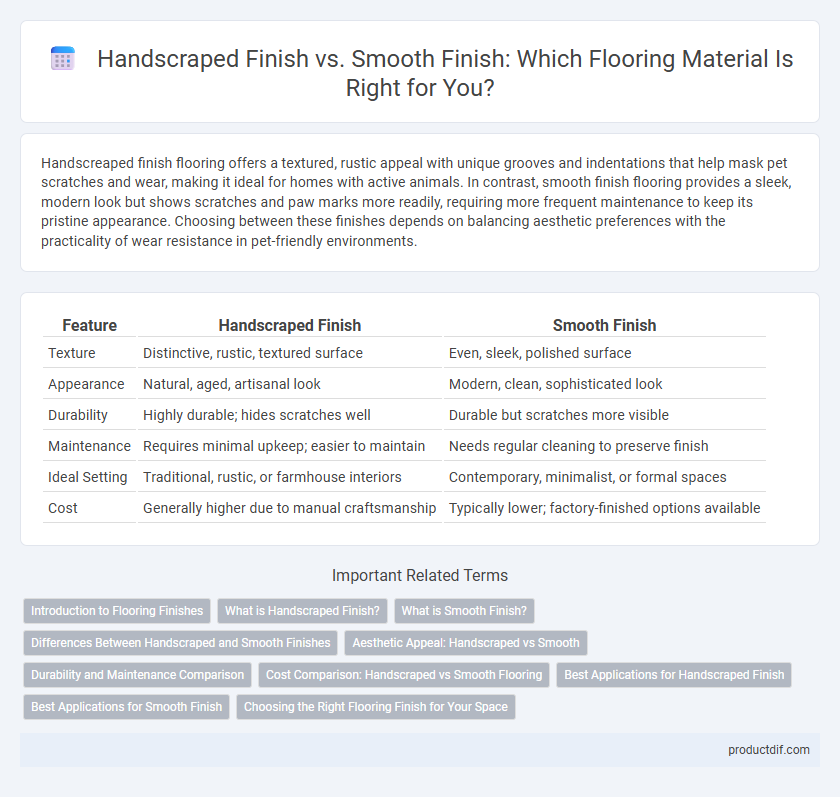Handscreaped finish flooring offers a textured, rustic appeal with unique grooves and indentations that help mask pet scratches and wear, making it ideal for homes with active animals. In contrast, smooth finish flooring provides a sleek, modern look but shows scratches and paw marks more readily, requiring more frequent maintenance to keep its pristine appearance. Choosing between these finishes depends on balancing aesthetic preferences with the practicality of wear resistance in pet-friendly environments.
Table of Comparison
| Feature | Handscraped Finish | Smooth Finish |
|---|---|---|
| Texture | Distinctive, rustic, textured surface | Even, sleek, polished surface |
| Appearance | Natural, aged, artisanal look | Modern, clean, sophisticated look |
| Durability | Highly durable; hides scratches well | Durable but scratches more visible |
| Maintenance | Requires minimal upkeep; easier to maintain | Needs regular cleaning to preserve finish |
| Ideal Setting | Traditional, rustic, or farmhouse interiors | Contemporary, minimalist, or formal spaces |
| Cost | Generally higher due to manual craftsmanship | Typically lower; factory-finished options available |
Introduction to Flooring Finishes
Handscreaped finish flooring offers a textured, rustic appearance with natural variations that enhance the wood's character, making it ideal for traditional and cozy interiors. Smooth finish flooring provides a sleek, polished look with a uniform surface that highlights the wood's grain and color, suited for modern and minimalist designs. Both finishes impact durability and maintenance, with handscraped floors masking scratches better, while smooth finishes are easier to clean.
What is Handscraped Finish?
Handscraped finish is a flooring technique where each plank is meticulously scraped by hand to create a textured, rustic appearance that mimics the look of aged wood. This finish enhances the natural grain and character of hardwood, offering a unique and warm aesthetic that conceals scratches and dents more effectively than smooth finishes. Popular in hardwood flooring options such as oak, hickory, and maple, handscraped floors enhance durability while providing a distinctive, artisanal charm.
What is Smooth Finish?
Smooth finish flooring features a sleek, even surface that highlights the natural grain and texture of wood without added grooves or distressing, providing a modern and polished look. This finish is achieved through precise sanding and sealing techniques that create a flawless, reflective surface ideal for contemporary interiors. Smooth finish floors are easier to clean and maintain, making them popular for high-traffic areas and homes seeking a minimalist aesthetic.
Differences Between Handscraped and Smooth Finishes
Handscraped finishes feature textured, uneven surfaces created by artisans, offering a rustic, aged appearance that adds character and conceals wear over time. Smooth finishes provide a sleek, even surface that enhances modern aesthetics and is easier to clean, but may show scratches and dents more readily. The choice between handscraped and smooth finishes affects maintenance requirements, durability perception, and overall design style in flooring projects.
Aesthetic Appeal: Handscraped vs Smooth
Handscraped flooring offers a rustic, textured aesthetic with subtle imperfections that add character and warmth to any space. Smooth finishes provide a sleek, modern look with a flawless surface that enhances light reflection and complements contemporary interiors. The choice between handscraped and smooth finishes significantly influences the overall ambiance and design style of a room.
Durability and Maintenance Comparison
Handsoreaped finish flooring offers increased durability due to its textured surface that effectively hides scratches and dents, reducing visible wear over time. Smooth finish flooring requires more frequent maintenance as scratches, dust, and dirt are more noticeable, necessitating regular cleaning and care to preserve its appearance. Both finishes benefit from proper sealing, but handscraped floors typically provide a more forgiving option in high-traffic environments.
Cost Comparison: Handscraped vs Smooth Flooring
Handscraped flooring typically costs 15-25% more than smooth flooring due to the labor-intensive process that creates its textured, worn look. Smooth flooring is less expensive because it requires less detailed craftsmanship and can be produced more quickly in large batches. When budgeting, choosing handscraped finish adds a premium for its artisanal appeal and unique character, while smooth finish offers a more cost-effective, modern aesthetic.
Best Applications for Handscraped Finish
Handscraped finish flooring is ideal for high-traffic areas and rustic or traditional interiors due to its textured surface that effectively hides scratches and dents. This finish offers enhanced slip resistance, making it suitable for homes with pets and children. It excels in creating a warm, aged look ideal for kitchens, living rooms, and cabins where character and durability are essential.
Best Applications for Smooth Finish
Smooth finish flooring offers a sleek, modern look ideal for high-traffic commercial spaces, contemporary homes, and minimalist interior designs. Its uniform surface is easier to clean and maintain, making it perfect for kitchens, bathrooms, and offices where hygiene and appearance are priorities. Smooth finishes also enhance natural light reflection, contributing to brighter rooms and a more open atmosphere.
Choosing the Right Flooring Finish for Your Space
Handscreped finishes offer a textured, rustic appearance that enhances character and hides scratches, making them ideal for high-traffic areas or homes with pets. Smooth finishes provide a sleek, modern look and are easier to clean, perfect for contemporary spaces prioritizing minimalism and cleanliness. Selecting between handscraped and smooth flooring depends on balancing aesthetic preference, maintenance needs, and the functional demands of the room.
Handscraped Finish vs Smooth Finish Infographic

 productdif.com
productdif.com